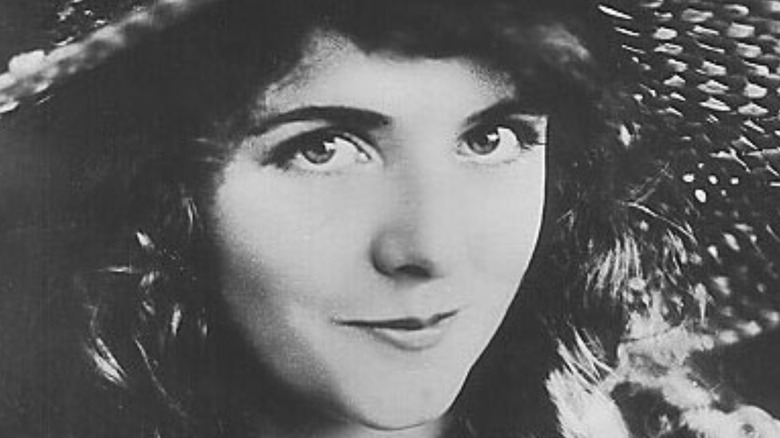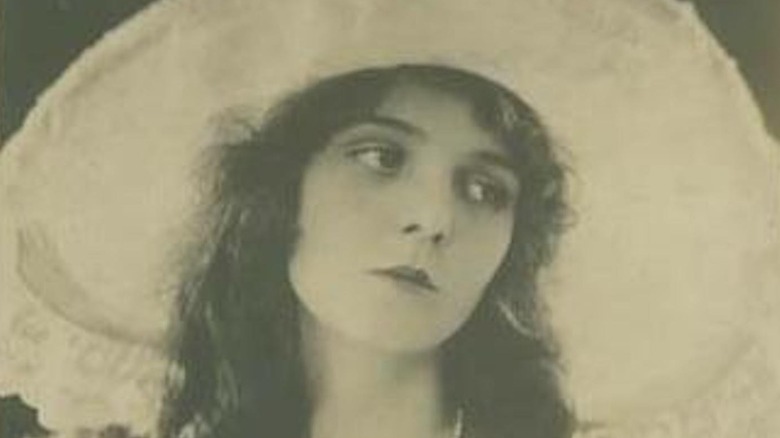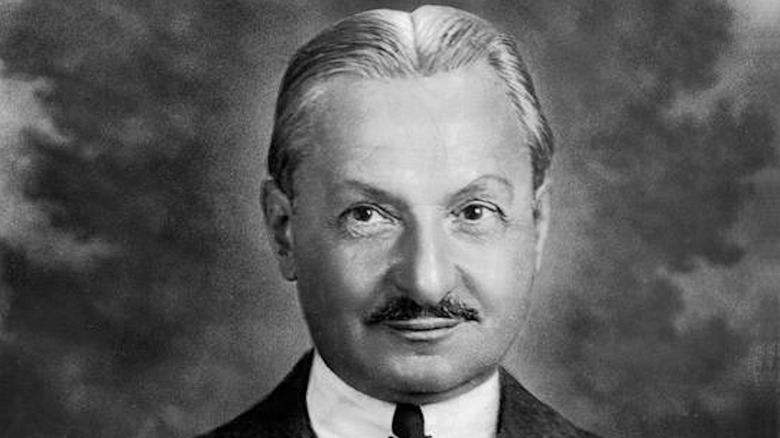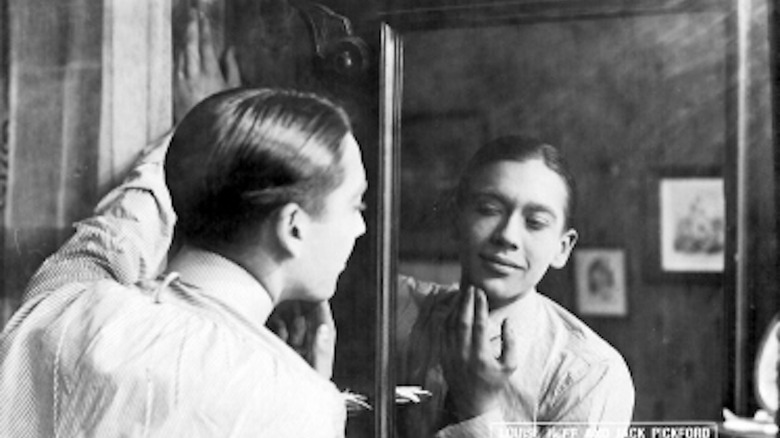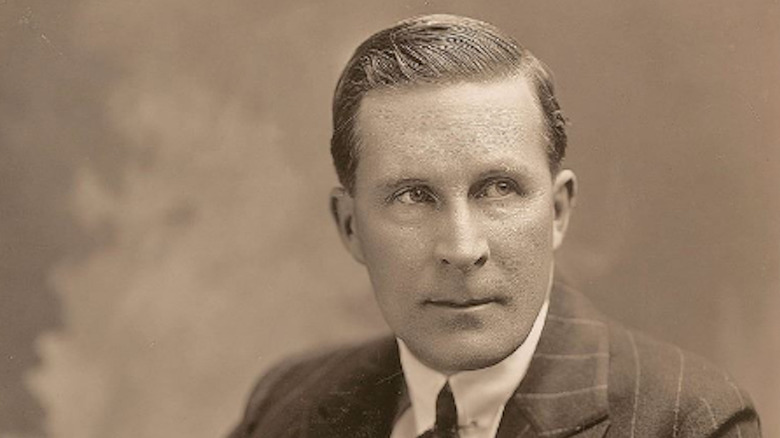What We Know About The Death Of Olive Thomas, One Of Hollywood's First Scandals
Olive Thomas was on top of her game as a silent-movie star in August 1920 when she died suddenly and mysteriously. The 25-year-old was on a belated honeymoon in Paris with her husband, Jack Pickford. They came back to the Hotel Ritz around 3 a.m. after a night of partying. Pickford later told the Los Angeles Examiner they had both "been drinking a little," but that was probably an understatement (via Bright Lights Film).
According to Pickford, Thomas was in the bathroom when she suddenly cried "My God!" He went to see what was wrong, only to find she had drunk poison. Depending on the story, it was either "toilet solution" or Pickford's syphilis medication, mercury bichloride, meant to be applied topically (via Bright Lights Film and the Pittsburgh Post-Gazette). She had thought it was either headache medicine or a sleep tonic, again, depending on the story (via Timeline and the Pittsburgh Post-Gazette). She died five days later, at which point she was blind and her vocal cords corroded because of the poison, according to Timeline. Pickford was the only person present when Thomas drank the poison. So was he telling the truth?
The early life of Olive Thomas
Thomas was born Oliva or Oliveretta Elaine Duffy in Charleroi, Pennsylvania, near Pittsburgh, in 1894 (via Timeline). Her father was a steelworker. She left school at age 15 to work, and the next year married her first husband, Bernard Thomas, according to the Pittsburgh Post-Gazette. Later, she left her husband, moved to New York, and got a job in a department store in Harlem. Once there, she entered a contest for "The Most Beautiful Girl in New York City" and won (via Timeline).
This was what propelled her to fame. She became a model for various artists, including Harrison Fisher, who dubbed her the most beautiful girl in America (via the Spartanburg Herald-Journal). Shortly thereafter, in 1915, she became one of the Ziegfeld Follies showgirls. She featured in "Midnight Frolic," one of Flo Ziegfeld's many scandalous revues, in which the girls wore strategically-placed balloons, which the male audience members could pop. During this time, she also had an affair with the married Ziegfeld, according to the Pittsburgh Post-Gazette. She began making movies in 1916 (via Timeline).
Olive 'the flapper'
Thomas' film career took off quickly. She was contracted by Triangle Pictures and moved to Hollywood. Later, producer David O. Selznick created a new studio, Selznick Pictures, built around her specifically, according to the Pittsburgh Post-Gazette. He contracted her for eight films per year; by 1920, she had made 19 total (via Timeline).
Thomas's last film was "The Flapper," which became a success because of the notoriety surrounding her death (via Timeline). The "flappers" were young women who bucked convention, behaving and dressing as they pleased (via Dictionary). Thomas represented the shift from the old-fashioned, reticent heroines like those her sister-in-law Mary Pickford played and the particularly daring and sexy flappers of the later 1920s like Clara Bow. Deep down, flappers were supposed to have hearts of gold, and Thomas typified that with her closeness and generosity to her family, even after she became famous, according to the Pittsburgh Post-Gazette.
Theories about her death
Because Pickford was the only person with Thomas when she swallowed poison, he immediately came under suspicion. The inconsistency in his and others' accounts of what happened didn't help him. In addition to the discrepancies about what she swallowed and why, various stories also claimed she couldn't speak for the last few days of her life, or that she was calling out for Pickford and spoke to him in her last moments. The New York Times reported Thomas had taken out a large life insurance policy only weeks before her death, which didn't help Pickford's case, either (via Bright Lights Film)
Thomas and Pickford's marriage was known to be intense and rocky, though loving. While some suspected Pickford of murdering his wife, others suspected Thomas had been driven to suicide because of Pickford's infidelity and their fights (via Timeline). Florenz Ziegfeld (above) even claimed Pickford had broken Thomas' heart, according to Bright Lights Film. Film star Mary Pickford manipulated press accounts of the case somewhat in her brother's favor, according to the Pittsburgh Post-Gazette. Despite all the speculation, the attending doctor ruled Thomas's death an accident (via Timeline).
Jack Pickford
So who was Jack Pickford, Thomas's suspicious husband? He was the brother of the better-known Mary Pickford but had a semi-successful film career himself (via Bright Lights Film). When he and Thomas married in 1918, she kept her first husband's name because she wanted to earn success herself and not be seen as riding on the Pickfords' coattails. Jack Pickford (above) was known as a womanizer, and he apparently kept that up after their marriage, according to Timeline.
Thomas' death wasn't the first scandal linked to him, either. He joined the Navy in 1918 and got involved in a scheme to aid other men in dodging military service. He was court-martialed and dishonorably discharged, but as he became a state witness in the related trial, his discharge was changed to a medical one (via Bright Lights Film).
Pickford continued to make movies until around 1928, when films with sound were introduced. He married twice more, to two more Ziegfeld girls, but neither marriage lasted (via Bright Lights Film).
The aftermath
Olive Thomas' death did nothing for Hollywood's reputation. Since she and Pickford's hard-partying lifestyle was seen as partially to blame, the press began writing about the drug problems and immorality of the Hollywood elite. It was the first in a series of scandals that rocked the film industry. These included the murder of director William Desmond Taylor (above) in 1922, the drug-related death of actor Wallace Reid in 1923, and the accusations of rape and manslaughter against comedian Fatty Arbuckle following the death of actress Virginia Rappe at a party in 1921. Arbuckle was found innocent, and Pickford was never proven guilty, but both of their reputations suffered nonetheless (via Bright Lights Film).
The public shock and outrage that followed these scandals eventually led to changes in the film industry. They are the reason many actors have had morality clauses in their contracts since then, according to Timeline. They also led to the introduction of the Motion Picture Production Code, aka the Hays Code, which regulated morality in films from 1934-1968 (via Bright Lights Film). Though Thomas is little remembered today, her death cast a long-lasting shadow over Hollywood.
